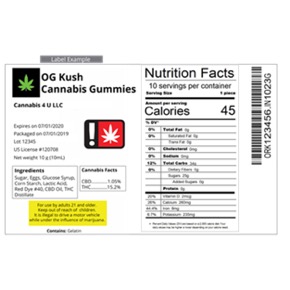Back in late 2016, the Oregon Liquor Control Commission (OLCC) legalized delivery for cannabis products. Since then, dispensaries could offer a delivery option for their customers to purchase cannabis products without leaving the comfort of their home. Up until quite recently, that market was dominated by a handful of dispensaries who also conduct business at their physical location, offering delivery as an option while conducting most sales in-person.
Enter Pot Mates. Founded in 2018 by Hammond Potter, the company embarked on the long regulatory road towards licensing and beginning operations. On April 20, 2020, Pot Mates opened for business, starting their engines to take on the fledgling cannabis delivery market in Portland.
Pot Mates is a tech startup through and through. The founders are former Apple employees. Hakon Khajavei, the chief marketing officer at Pot Mates, founded Blackline Collective, a business and marketing consultancy, which is where he joined the Pot Mates team. The other co-founder of Pot Mates and chief technology officer, Jason Hinson, joined after serving in the US Navy as an electronics technician maintaining satellite communications networks.
With the sheer amount of regulations for cannabis businesses, coupled with the new delivery-based business model, Pot Mates had to focus on technology and automation from the get-go.
Not Just an Online Dispensary
For the cannabis companies already offering delivery in the Portland metro area, their websites seem to mimic the in-person dispensary experience. They offer dozens of products for each category, like concentrates, edibles and flower, making a customer pour through options, all at different price points, which can get confusing for the average consumer.

Pot Mates does things a little differently. “Our start up process was thinking through how do we make this the best experience possible, how do we get rid of the unnecessary junk and how do we do things that only an online dispensary can do,” says Khajavei. They have flat pricing across the board. In each category, almost every product is priced the same, moving away from the common tiered-pricing model. This, Khajavei says, removes the decision barriers customers often face. Instead of choosing the right price point, they can choose the delivery mechanism and effect they desire uninhibited by a difference in cost.
It all comes back to focusing on the simplest way for someone to buy cannabis. “Shopping online is just very different,” says Khajavei. “Our process focuses on the customer journey and limits the number of products we offer. We have a mood system, where we tag our products from reviews to typify moods that you experience with different products.” All of that requires a lot of back-end technology built into their website.
The Long Regulatory Road
Technology has been a strong suit for Pot Mates since they opened their doors, and well before that too. Making the decision to be an online-only delivery cannabis company pushed them to pursue a very unique business model, but regulations dictate a lot of the same requirements that one might see in dispensaries.

The same rules apply to them when Pot Mates submitted their license application. You need to have a signed lease, extreme security measures, detailed business plans, integrated seed-to-sale traceability software (Metrc in Oregon) and much more. “During the months leading up to getting our license, we were able to iron out a lot of the regulatory details ahead of time,” says Khajavei. A lot of that was about security and tracking their products, which is why technology plays such a huge role in their ongoing regulatory compliance efforts. “We built in a lot of automation in our system for regulatory compliance,” says Khajavei. “Because of our technology, we are a lot faster.”
In the end, their licensing process through the state of Oregon as well as the city of Portland took about nine months. Once they had the license, they could finally get down to business and begin the process of building their website, their POS system, their inventory and reaching out to partners, producers, distributors and growers.
For any cannabis company, there are a number of regulations unique to their business. “We need to report every product movement in house through Metrc,” says Khajavei. “Every time something is repackaged it needs to be reported. We focus so much on our technology and automation because these regulations force us to do so.” But delivery companies are required to report even more. Pot Mates needs to report every single movement a product makes until it reaches the customer. Before the delivery can leave the shop, it is reported to Metrc with an intended route, using turn-by-turn directions. It complicates things when you make two or more deliveries in one trip. Reporting a daisy chain of deliveries a vehicle makes with turn-by-turn directions to regulatory authorities can get very tedious.
As far as regulations go for delivery parameters, they can legally deliver anywhere inside Portland city limits. “It is our job to figure that out, not the customer’s job; so we don’t have any distance limits, as long as it is residential,” Khajavei says. “We programmed customized technology that allows us to handle really small orders.” Without a minimum order policy or a distance limit, Pot Mates can reach a much bigger group of consumers.
Launching in the Midst of a Global Pandemic

Luckily, the Pot Mates team received their license just in time. About two weeks after they submitted their application, Oregon put a moratorium on any new dispensaries.
They went forward with their launch on April 20 this year, despite the coronavirus pandemic impacting just about every business in the world, including their marketing efforts tremendously. With cannabis deemed essential by the state, they could operate business as usual, just with some extra precautions. What’s good for PotMates is that they don’t need to worry about keeping social distancing policies for customers or curbside pickup, given the lack of storefront.
They still need to keep their team safe though. The Pot Mates team began 3D printing washable and reusable face masks, getting more gloves for delivery drivers, cleaning their warehouse thoroughly, cleaning vehicles and making sure employees maintained distancing. Pot Mates is even 3D printing enough masks and donating them to local organizations that need access to masks. “As a cannabis company, we always have to handle things with gloves here and take necessary safety precautions anyway, so our response is more about how we can help than what we need to change.”
Advertising Cannabis in a Pandemic is No Easy Task
“The marketing aspect is where covid-19 really hurt us,” says Khajavei. “There are so many regulations for cannabis companies advertising already. Unlike other products, we can’t just put up advertisements anywhere. We have to follow very specific rules.” So, in addition to the normal marketing woes in the cannabis industry, the team then had to deal with a pandemic.
Pot Mates had to scrap their entire marketing strategy for 2020 and redo it. “We wanted to begin with a lot of face-to-face marketing at events, but that didn’t quite work out so well.” Without any concerts, industry events or large gatherings of any kind, Pot Mates had to pivot to digital marketing entirely. They started building their SEO, growing their following on social media, producing content in the form of blogs and education around cannabis and the local laws.
On an Upward Trajectory
Obviously, the short-term problem for a new cannabis company is reaching people, especially during the COVID-19 crisis. “We have a good trajectory though, we know we are growing our business, but we still have a ways to go,” says Khajavei. It doesn’t help that social media companies have nonsensical policies regarding cannabis. Their Facebook page was recently removed too.

But the bigger issue here is kind of surprising when you first hear it: “It’s not even a matter of customer preference, a lot of people just have no idea that delivery is even legal.”
It’s pretty evident that cannabis delivery has not really gone mainstream yet. “We’ve told people about our business in the past and a common answer we get is, ‘Oh my gosh, I didn’t even know we could get cannabis delivered.’” It’s never crossed their mind that they can get cannabis delivered to their home. It’s an awareness problem. It’s a marketing problem. But it’s a good problem to have and the solution lies in outreach. Through educational content they post on social media and in their blog, Khajavei wants to spread the word: “Hey, this is a real thing, you can get cannabis delivered.”
As the market develops and as consumers begin to key in on cannabis delivery, there’s nowhere to go but up. Especially in the age of Amazon and COVID-19 where consumers can get literally anything they can dream of delivered to their front door.
Moving forward, Pot Mates has plans to expand as soon as they can. Right now, they’re limited to Portland city limits, but there’s a massive population just outside of Portland in towns like Beaverton, Tigard and Tualatin. “We are so close to these population centers but can’t deliver to them now because of the rules. We want to work with OLCC about this and hopefully change the rules to allow us to deliver outside of the city limits,” says Khajavei. In the long term, they plan to expand out of state, with Washington on their north border being first on the docket.
To the average person, one would think launching a delivery cannabis business in the midst of a global pandemic would be a walk in the park, but Pot Mates proved it’s no easy task. As the market develops and the health crisis continues, it seems the Oregon market will react positively to the nascent delivery market, but first they need to know it is even an option.



























